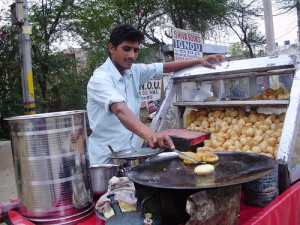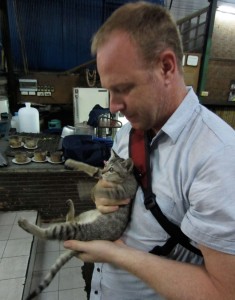The U.S. food truck movement isn’t quite the same (or as authentic) as buying a hot tamale, salsa and guacamole out of a bag in Central America or samosas from a street stall in India.
But the concerns are the same – can the vendor manage the hazards associated with their foods? Prepping some food off site, transporting it, holding it and taking home the leftovers (and maybe reselling them) can be more complicated than making food in a restaurant. Especially when it comes to handwashing and cross-contamination.
According to the Economic Times, New Delhi street food vendors are getting trained.
Vendors selling street food in the national capital will now be sensitised about health and
hygiene for raising food safety standards.
Health Minister J P Nadda today launched the project titled as ‘Clean Street Food’ to be undertaken by Food Safety and Standards Authority of India (FSSAI).
The FSSAI will train street food vendors under the Recognition of Prior Learning category of the Centre’s skills training scheme, Pradhan Mantri Kaushal Vikas Yojana.
Speaking at the launch of the Project, Nadda said it is a pragmatic, practical, constructive and positive approach to skilling one of the largest unorganised sectors of the country.
“With nearly 20 lakh street vendors in the country, the training of 20,000 vendors on a pilot basis in the NCR of Delhi is a welcome steep. As street food forms an integral part of our society, the project which shall upgrade the skills of the street food vendors, will also contribute to preventive and promotive health,” he said.
Besides, the FSSAI also launched a Mobile App to empower citizens to reach out to the food enforcement machinery for any concerns or suggestions that they may have on the issue of food safety.
Being sensitized to the risks is a start; addressing them is what makes food safer.










 way that would be difficult in a proper brick and mortar eatery (right, vegetarian mi quang, a thick noodle common to Central Vietnam, served in a Ho Chi Minh City street stall. Credit: Dave Hagerman).
way that would be difficult in a proper brick and mortar eatery (right, vegetarian mi quang, a thick noodle common to Central Vietnam, served in a Ho Chi Minh City street stall. Credit: Dave Hagerman)..jpeg) poop," is Powell’s blunt advice. "But if you’re going to eat it, make sure it’s cooked." Street food vendors have a particular challenge because they work in small spaces, facilitating cross-contamination between "clean" and "dirty" foods.
poop," is Powell’s blunt advice. "But if you’re going to eat it, make sure it’s cooked." Street food vendors have a particular challenge because they work in small spaces, facilitating cross-contamination between "clean" and "dirty" foods.